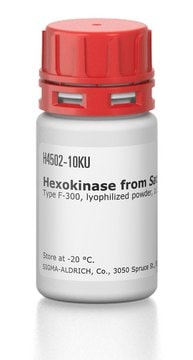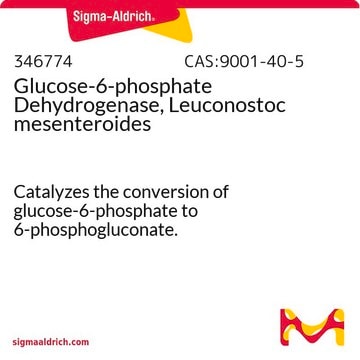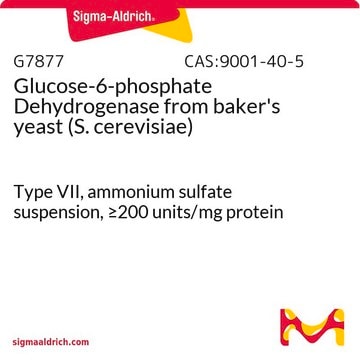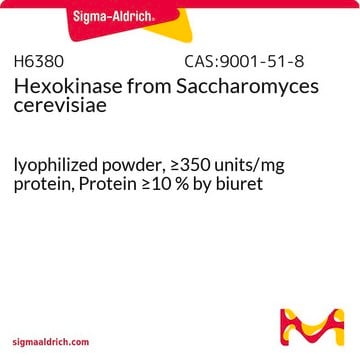The stability of this product in solution has not been determined beyond the 1 - 2 month recommended for freezer storage. However, similar product 346774, under the CalBiochem tradename, is stable at 2 - 8°C up to 6 months when prepared at 1 mg/mL in 5 mM glycine buffer, pH 8. See the link below to review this information:
https://www.emdmillipore.com/product/Glucose-6-phosphate-Dehydrogenase-Leuconostoc-mesenteroides,EMD_BIO-346774#anchor_PDS
G8529
Glucose-6-phosphate Dehydrogenase from Leuconostoc mesenteroides
recombinant, expressed in E. coli, lyophilized powder, ≥550 units/mg protein (biuret)
Synonym(s):
G-6-P-DH
About This Item
Recommended Products
recombinant
expressed in E. coli
Quality Level
form
lyophilized powder
specific activity
≥550 units/mg protein (biuret)
composition
Protein, 10-40% biuret
application(s)
agriculture
foreign activity
creatine phosphokinase, glutathione reductase, myokinase, NADH oxidase, NADPH oxidase, phosphoglucomutase, 6-phosphogluconic dehydrogenase, phosphoglucose isomerase, lactic dehydrogenase, hexokinase ≤0.01%
storage temp.
2-8°C
Looking for similar products? Visit Product Comparison Guide
Application
- in the coupled spectrophotometric assay for PGI (F6P to G6P reaction)
- to study the starch time course using Nicotiana tabacum leaves
- to determine the glucose content in the root and stem samples of Quercus velutina Lam. saplings
- to assay glucose using a starch sample of wild-type and transgenic Arabidopsis whole seedlings
Biochem/physiol Actions
Unit Definition
Physical form
Storage Class Code
11 - Combustible Solids
WGK
WGK 3
Flash Point(F)
Not applicable
Flash Point(C)
Not applicable
Personal Protective Equipment
Choose from one of the most recent versions:
Certificates of Analysis (COA)
Don't see the Right Version?
If you require a particular version, you can look up a specific certificate by the Lot or Batch number.
Already Own This Product?
Find documentation for the products that you have recently purchased in the Document Library.
Customers Also Viewed
-
If Product No. G8529, Glucose-6-phosphate Dehydrogenase, recombinant from Leuconostoc mesenteroides, dissolved in Glycine 5mM, Can enzyme with Glycine buffer be stable for more than 2 months at -20°C?
1 answer-
Helpful?
-
-
Can solutions of Product No. G8529, Glucose-6-phosphate Dehydrogenase, recombinant from Leuconostoc mesenteroides, be stored?
1 answer-
This product may be stored in aliquots at -20°C in citrate buffer for approximately 1-2 months. Note that product G8404 is an ammonium sulfate suspension that may be stored at 2-8°C.
Helpful?
-
-
What are the differences between Product No. G8529, Glucose-6-phosphate Dehydrogenase and Product No. G5885, Glucose-6-phosphate Dehydrogenase?
1 answer-
Product No. G8529 is a recombinant protein from Leuconostoc mesenteroides, expressed in Escherichia coli. Product No. G5885 is a non-recombinant protein from Leuconostoc mesenteroides.
Helpful?
-
-
What is the Department of Transportation shipping information for this product?
1 answer-
Transportation information can be found in Section 14 of the product's (M)SDS.To access the shipping information for this material, use the link on the product detail page for the product.
Helpful?
-
-
For Product No. G8529, Glucose-6-phosphate Dehydrogenase from Leuconostoc mesenteroides, can the Ficoll present in the product be removed?
1 answer-
Ficoll is added to the enzyme preparation as a stabilizer. The enzyme may become unstable if the Ficoll is removed (i.e., through a dialysis step).
Helpful?
-
-
In which solvent can Product No. G8529, Glucose- 6-phosphate Dehydrogenase from Leuconostoc mesenteroides, be dissolved?
1 answer-
The product can be dissolved at 1 mg/ml in 5 mM glycine buffer, pH 8, (with or without 0.1% BSA) or in deionized water at 1 mg/ml (buffer is preferable)
Helpful?
-
-
What is the molecular weight of Product No. G8529, Glucose-6-phosphate Dehydrogenase?
1 answer-
Sigma has not determined the molecular weight of this protein, but a value of 55,000 daltons has been reported for the monomer molecular weight (the enzyme from Leuconostoc mesenteroides is reportedly a dimer protein) (Biochem. Biophys. Res. Comm. 59, 894 (1974)).
Helpful?
-
Active Filters
Our team of scientists has experience in all areas of research including Life Science, Material Science, Chemical Synthesis, Chromatography, Analytical and many others.
Contact Technical Service










